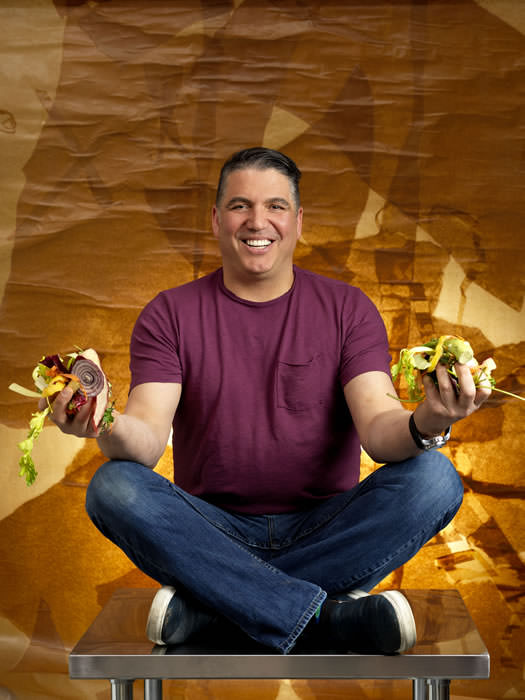cover
ROOT TO STALK
Tackling food waste in a surprisingly tasty way.
WRITTEN BY BARBARA TWITCHELL
PHOTOS BY JEFF ROSS
It’s grocery day. You’ve just plunked down your hard-earned dollars to pay for four bags of groceries. You load them into your car, drive to the nearest trash bin, and throw one of them away. Right? Of course not! Who would do that?
Would you believe, in a way, practically every one of us does it?
Sustainable America reports that Americans waste 25 percent of the food we buy. And that’s just in our own kitchens.
On a larger scale, up to 40 percent of the food we grow in this country is wasted on the journey from farm to fork. That’s 34.7 million tons of food — at an estimated worth of $165 billion — that end up in landfills every year. To make matters worse, all that rotting food releases massive amounts of methane, which scientists recognize as a significant contributor to climate change.
Despite the fact that 49 million Americans live in food-insecure homes, this unconscionable waste continues to spiral out of control. Incredibly, the amount of food waste in the U.S. has actually tripled since the 1950s.

Reduce, reuse, recycle
So what can we do about this shameful problem? The three Rs are a good place to start: reduce, reuse, recycle. Many of us may already practice these principles in our lives — plan meals, buy only what you need, use what you buy, eat your leftovers, compost, and so on. (To see how your own food waste habits rank, take this fast, easy test at Ivaluefood.com/quiz.php. The site also offers many helpful, practical ideas for curbing food waste.)
But while most of us think of food waste as dried-out leftovers or spoiled veggies that overstayed their welcome in the back of the refrigerator, they’re only part of the problem. Sadly, much of the food we throw away every day actually is fresh, nutritious, and perfectly good. And we don’t even realize it.
Nationally, there has been a major movement in the food industry to reduce waste by embracing a root-to-stalk philosophy. Root-to-stalk means exactly what it sounds like — utilizing the entire fruit or vegetable. And the good news is, with a little forethought, education, and creativity, it’s something we all can do in our own kitchens.


Tips and tricks
Here’s some research to get you started on this emerging culinary adventure. We’ve also tapped the creative talents of several local food purveyors, restaurateurs, and chefs known to be community leaders in the root-to-stalk movement and asked them to share some tips and recipes for utilizing food scraps in delicious ways.
- Valuing scraps requires changing your mindset. Every time you peel, trim, or core produce and toss the scraps in the trash, you actually are throwing away tasty, nutritious food. Start treating scraps as real food, not garbage. Jen Boscovich, nutritionist and co-owner of BFF Café in Reno, says before she starts meal preparation, she always sets up a waste plate on her counter for her peels and cuttings. She then transfers them to a freezer bag or plastic container and freezes them for later use in stocks, broths, or smoothies.
- Making vegetable broths and stocks is a great way to use food scraps. You can put almost any veggie peels and cuttings (scraps from cruciferous vegetables — such as Brussels sprouts, kale, cauliflower, cabbage, broccoli — not advised, as they can overpower the flavor and make it bitter) into water, simmer them for an hour or two (or six to eight hours in a slow cooker), strain with a fine-mesh strainer, and discard or compost veggie pulp. The wonderful stock or broth can be used as a base for soups and stews or to flavor many other dishes. Skeptical? Don’t be. All the chefs we spoke with use food scraps to create their stocks.
- Stalks and stems are just as nutritious as the leaves and florets they support, yet they generally end up in the trash. Broccoli stems, once peeled, offer many culinary options. They can be sliced and added to stir-frys, cooked and eaten on their own, or julienned and tossed raw into salads or slaws for great flavor and crunch. Mark Estee, owner/chef of Liberty Food & Wine Exchange in Reno, likes to serve them thinly cut and blanched, paired with fresh cherry tomatoes, and finished with a drizzle of warm olive oil and some chili flakes. Yum!
- Kale and chard stems can be used to make broths or to really pump up the nutrition factor when added raw to vegetable juices. They also can be shaved and added to salads, mixed into homemade veggie burgers, or cut up and thrown into stir-frys (add them first to give them extra time to cook before adding other vegetables).
- Making mashed potatoes? Save the well-scrubbed potato peels to make a crispy potato-chip-like treat. Toss the peels in olive oil, sprinkle with a little salt and pepper, then roast them at 350 degrees F for about 20 to 25 minutes.
- The woody ends of asparagus spears can be finely chopped and added to pesto for an extra pop of fiber and nutrition.
- Watermelon rinds are safe to eat and actually highly nutritious. Who knew? They can be eaten as is or used to replace cucumbers in some recipes such as gazpacho. They also can be candied or made into chutney. Jada McGirt, prepared foods manager at the Great Basin Community Food Co-op in Reno, uses an old family recipe to pickle them (click here for recipe).
- Those strawberry leaves you’ve been trashing actually contain higher levels of antioxidants than the berries. You can add the leaves to your salad. You might want to do as Boscovich does: Toss the whole berry, leaves and all, into the blender when you make a smoothie.
- Lemon rinds have powerful anti-cancer properties and more vitamins than lemon juice. Grate them and use them to flavor soups, salads, and baked goods, as well as fish, chicken, or vegetables. You can do the same with orange, grapefruit, or lime rinds.
- Squash scraps deserve a category unto themselves. Squash skins are loaded with antioxidants, so be sure to use any peels or scraps to make broths or juices (though not recommended for tough spaghetti squash skin). Squash blossoms are believed to have anti-carcinogenic properties. They also are delicious dusted with a light coating of flour and sautéed. Spaghetti squash seeds are simple to roast, just like pumpkin seeds, and taste similar.
- Onion skins and trimmings are a well-kept secret to creating delicious stocks, broths, or soups. Ditto with carrot peels and celery leaves. Never throw them away! Toss these scraps into a reusable container in the freezer. They’re all you need to make a great vegetable stock, according to McGirt, who saves those scraps from other meals she prepares. In case you have any doubts about its flavor, Andrew Yokom, the co-op’s operations manager, says McGirt’s stock is so popular, the store sells about 40 gallons of it every week.
- Mushrooms getting mushy? Don’t toss them. McGirt advises slicing them, spreading them out on a sheet pan, and placing them in a cool, dry place in your kitchen. In about a week, you’ll have dried mushrooms that can be stored until you’re ready to add them to soups or stews.
- Corn cobs, husks, and silk, while not exactly edible, can be used in food preparation. Cobs can be added to broths for added nutrition and flavor. Husks can be used to make tamales as well as to wrap other foods to be baked or steamed. Corn silk, valued in other countries for its medicinal properties, can be steeped to make tea.
- Juicing is tops when it comes to using scraps, according to Tim Healion, owner/manager of the Laughing Planet restaurants in Reno. Laughing Planet’s cooks use a lot of produce, he says, and all the cuttings and cores make their way to the juice bar, where their nutrition is captured in a tasty beverage (see recipe). If you don’t have a juicer, Healion suggests that you check out thrift stores. “Lots of people get them for gifts and never use them,” he says. “They end up in the thrift store, where you can pick one up for a great price.”
- Have bananas that are brown and spotty? Don’t throw them out. They’re actually at their peak of sweetness. Remove the peels, freeze the bananas, and add one to your next smoothie, McGirt advises.
- Avocados ripening faster than you can use them? They can be mashed, mixed with a little lemon juice, and frozen for later use in guacamole.
- Stems of all kinds (parsley, dill, cilantro) can be whirred in a food processor with lemon zest and garlic to make a salsa verde that can be added to potato salad or spooned onto fish for extra pizzaz.
- Carrot tops can be used to make a great pesto, according to Estee (see recipe). He says the same can be done with stems from cilantro, parsley, or spinach.
This is just a small list of possibilities. The Internet is full of ideas and recipes, so jump in and experiment. How often do you get the opportunity to help the environment, reduce food waste, save money, and expand your palate, all at the same time? And, theoretically speaking, maybe make it home with all four bags of groceries?
Freelance writer Barbara Twitchell admits to using onion, carrot, and celery trimmings to make soups, long before it was trendy. After researching this article and interviewing such innovative, local food gurus, she’s excited to try other ways to enjoy delicious food scraps.
Recipes
Carrot Top Pesto
(courtesy of Mark Estee, owner and chef, Liberty Food & Wine Exchange and chez louie in Reno. Makes 2½ cups)
4 cups packed, cleaned carrot tops (leaves)
½ cup extra-virgin olive oil
4 tablespoons garlic
½ cup grana Padano cheese
¼ cup lemon juice
½ cup toasted pine nuts
Kosher salt
Fresh black pepper
Pulse all items in blender or mix in mortar and pestle. Season with kosher salt and fresh black pepper. Add a little more olive oil if you like.
Pickled Watermelon Rind
(courtesy of Jada McGirt, prepared foods manager, Great Basin Community Food Co-op in Reno. Fills 10 pint jars)
4 pounds watermelon rind
2 cups white vinegar
2 cups water
4 cups sugar
3 cinnamon sticks
1 teaspoon whole cloves
1 teaspoon whole allspice
1 lemon, thinly sliced
Brine
¼ cup kosher salt
1 quart water
Pare watermelon rind and remove all pink portions. Cut rind into pieces about 1 to 2 inches thick or into ¾-inch-by-1-inch cubes. Weigh to make sure you reach 4 pounds. Soak rinds overnight in brine made by dissolving ¼ cup salt in each quart of water (make enough brine to cover). Drain rinds, rinse in fresh water, and re-drain. Combine remaining ingredients and boil together 5 minutes (spices may be tied in cheesecloth bag, if desired). Add rinds, a few at a time, and simmer about 30 minutes until rinds are clear. Pack rinds in hot, sterilized jars. Cover with boiling syrup and seal.
Laughing Planet Juice #3
(courtesy of Tim Healion, manager, Laughing Planet in Reno. Makes 1 16-ounce or 2 8-ounce servings)
Piece of unpeeled ginger, half the size of your thumb
½ fresh lemon
2 handfuls kale stalks
½ fresh cucumber
2 green apples or as much as needed to create enough juice to fill a 16-ounce or pint glass
Wash produce and roughly cut as needed to fit in juicer. Process it all, including peels, seeds, pulp, stems, whatever … it’s all good!
BFF Vegetable Broth
(courtesy of Jen Boscovich, registered nurse, nutritionist, and co-owner BFF Café in Reno. Yields 3 quarts or 12 1-cup servings)
“One of the secrets to outstanding soup, flavorful rice, great sauce, and amazing quinoa is starting with a good broth,” Boscovich says. “Making veggie scraps into broth before you throw them into the compost pile is a good way to get double use out of them. Simply add your vegetable scraps to a freezer bag or container and keep frozen until you have enough (2 to 3 cups) to make broth.”
2 onions, chopped
3 celery stalks, chopped
2 garlic cloves, minced
2 medium carrots, chopped
2 to 3 cups fresh, well-washed vegetable scraps (Great additions include the skin, root, and tops of onions; celery root and leaves; carrot tips, peels, and shoulders; corn cobs; and any part of leeks, green onions, zucchinis, or parsnips.)
1 tablespoon extra-virgin olive oil or coconut oil
2 medium tomatoes, chopped
½ cup parsley, chopped
12 cups cold, filtered water
½ to 1 teaspoon salt (or to taste)
Thoroughly wash and chop all vegetables. Heat oil in a pot and add first 5 ingredients. Lightly sauté vegetables until brown. Add cold water. Different flavors are extracted at different temperatures, so starting with cold water and slowly increasing the temperature helps more flavors get extracted. Turn heat to medium and slowly bring to just under a boil. Reduce heat and keep at a simmer for 1 to 1½ hours. Do not stir. When cool, strain through a fine-mesh strainer. Let broth cool, then pour into containers. Refrigerate or freeze until ready to use.
BFF Marinara
(courtesy of Jen Boscovich, nutritionist, and co-owner, BFF Café in Reno. Makes about 8 ½-cup servings)
Italian marinara sauce is cooked “low and slow” to create a thick and flavorful sauce, Boscovich says.
1 tablespoon olive oil
1 medium onion, chopped
3 garlic cloves, minced
1 carrot, diced
1 cup fresh vegetable scraps (carrot, kale, zucchini, tomatoes, eggplant, etc.)
1 teaspoon kosher salt
½ teaspoon dried oregano
½ teaspoon dried thyme
4 cups whole, peeled tomatoes
In large pot, heat olive oil over medium-low heat until hot. Add onion, garlic, carrot, vegetable scraps, salt, oregano, and thyme. Reduce heat to low and let aromatics sweat and soften until onions give no resistance to edge of spoon, 20 to 25 minutes. Add tomatoes. Increase heat to bring sauce to simmer. Cook, stirring occasionally and while breaking up tomatoes with your spoon, 15 to 20 minutes. Purée sauce until it reaches desired smoothness, either right in pot with hand blender or transferred to blender. Serve warm or place in container when cool to refrigerate or freeze.
Co-op Basic Vegetable Stock
(courtesy of Jada McGirt, prepared foods manager, Great Basin Community Food Co-op in Reno. Yields around 3 quarts)
About 4 cups well-washed kitchen scraps (onion skins, roots, and tops; celery roots, bottoms, and leaves; carrot peels, tips, shoulders)
12 to 14 cups water
Salt and pepper, to taste
Place all ingredients in large stockpot and simmer 1 to 1½ hours. Strain through fine-mesh strainer and discard or compost vegetable residue. Broth may be used as soup base or to flavor other dishes, or cooled and frozen for future use.


